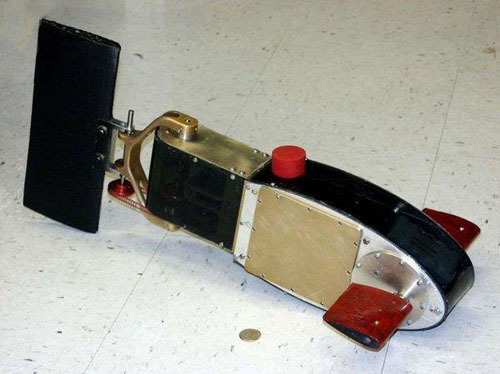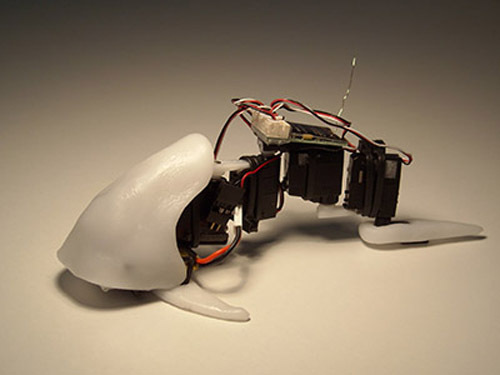
 In the spirit of my snake-bot roundup post from March, here are some super cool fish bots!
In the spirit of my snake-bot roundup post from March, here are some super cool fish bots!
The technology fascinates me. Can robot fish be used to play a sheepdog role for schools of fish, allowing them to be more efficiently harvested? Can we create machines that mimic the graceful movement of sea creatures, allowing for more efficient ship and submarine design? Can we use entire schools of networked robofish to explore and police the waters? Remember in the ’80s when the Navy caught heat for borging out dolphins — is this a more humane alternative?
Fishbot 1: BoxyBot
This autonomous bot designed in Ecole Polytechnique Fédérale de Lausanne in Switzerland,
[W]e designed BoxyBot, a simple fish robot with three actuated fins capable of swimming in water and crawling on firm ground… the robot is capable of performing and switching between a variety of different locomotor behaviors such as swimming forwards, swimming backwards, turning, rolling, moving upwards/downwards, and crawling. These behaviors are triggered and modulated by sensory input provided by light, water, and touch sensors.
Fishbot 2: AFAUV
The cleverly named Autonomous Fin-Actuated Underwater Vehicle has a unique twist: it attempts to get multiple bots to exhibit school behavior by using acoustic modems to communicate.
Robotic fish with flapping fins and tails have been programmed to swim in a school by researchers at the University of Washington in Seattle. They say that artificial fish with group behaviour could track marine pollutants or wildlife such as whales.
Artificial fish have been on the wish lists of oceanographers and the military for years. It is hoped that mimicking nature’s propulsion methods could allow vehicles to be more efficient and manoeuvrable, and deploying them in shoals would allow more complex missions.
Via New Scientist.
Watch a video of the bot: (The version pictured above is the second bot in the video.)
Fishbot 3: Robo-Carp
Computer scientists at the University of Essex in the U.K. developed the self-guided robot fish, seen here swimming in the aquarium. The designers say it is the smartest such robot yet created—the fish uses artificial intelligence and built-in sensors to avoid obstacles and respond to environmental changes.
The fish’s battery lasts for up to five hours, though the scientists hope to one day program it to search for and access a recharging station when it runs low.
Here are a couple of videos of the bot in motion:
Fishbot 4: PPF-09
(What is it about scientists not being able to come up with a cool name for their projects?)
We developed an experimental fish robot, UPF-2001 on 2001. It was tried to have 3-D motion including a turning and up-down motion, with two-axes fins. As the result of swiming tests, we confirmed that the fish robot does not have so bad performance of the up-down motion. However, it does not have high performance of the turning motion at all. The model fish robot, PPF-09 has fins for the up-down motion as the same of the UPF-2001. And The PPF-09 has the turning mechanism by the tail motion as the same of the experimental fish robot, PF-300. Their mechanisms will produce a good performance of the 3-D motion.
On the other hand, from the developments of many fish robots, we have confirmed seberal problems like a troublesome battery change, a difficult operation and a defective waterproofed body. The PPF-09 is an amusement fish robot, which has a simple handling, and it will give us great pleasure.
This product of Japan’s National Maritime Research Institute is remarkable mainly because its CAD files and schematics are downloadable. Start building!
Via BrePettis.com.
Fishbot 5: Flapper
This is a 4 channel, direct servo control r/c robotic fish. I’ve had this idea of making a robotic fish, originally it was going to be a swimming under water fish. 2 or 3 servos for the body/tail, and 2 channels for controlling the fins, to tilt side to side, and up and down, like flaperons. Rudder control would have been using the tail once momentum and forward movement is achieved.
I decided not to tackle on the underwater fish, as water proofing and boiency would be a nightmare to deal with. However I tackled on the mechanics of the body, using the transmitter sticks in a circular motion to move the servos in a snake like motion. After playing around with the mechanics, I realized I could flip it over, and back again, given how light the fish turned out to be. Servos are sub micro Walkeras, and using a light 1s lipo, and a micro Spektrum AR6300 receiver. As like swashbots and tortoise, no programing is involved…. motions are accomplished only with the transmitter sticks.
Watch a video of the bot:
Via the MAKE blog
Fishbot 6: Tai-Robot-Kun
The robotic fish can swim for an hour on a full battery charge, and it relies on a ballast system similar to those used in submarines to adjust its buoyancy and depth. Tai-robot-kun’s creator, professor Ikuo Yamamoto, says the robot can easily be mass-produced, outfitted with various cameras and sensors, and released into the sea to perform a wide range of oceanographic survey tasks. He adds that because the robot swims silently and looks like a real fish, it would be able to gather data without alarming the creatures it encounters. Yamamoto and his team are also reportedly developing a robotic manta ray that uses some of the same technology.
Watch a video of the bot:
Via Pink Tentacle.
![Reblog this post [with Zemanta]](http://img.zemanta.com/reblog_e.png?x-id=71504853-e822-4f14-883f-845597a3c4a0)







